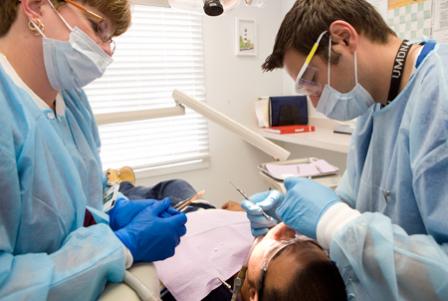Dental Effluent Guidelines

Dental offices discharge mercury present in amalgam used for fillings. Amalgam separators are a practical, affordable and readily available technology for capturing mercury and other metals before they are discharged into sewers that drain to POTWs. Once captured by a separator, mercury can be recycled.
EPA expects compliance with this final rule will annually reduce the discharge of mercury by 5.1 tons as well as 5.3 tons of other metals found in waste dental amalgam to POTWs.
Background
Mercury is a potent neurotoxin that bioaccumulates in fish and shellfish. Mercury pollution is widespread and a global concern that originates from many diverse sources such as air deposition from municipal and industrial incinerators and combustion of fossil fuels.
- Dental clinics are the main source of mercury discharges to POTWs.
- EPA estimates about 103,000 dental offices use or remove amalgam in the United States; almost all of these send their wastewater to POTWs.
- Dentists discharge approximately 5.1 tons of mercury each year to POTWs; most of this mercury is subsequently released to the environment.
Mercury-containing amalgam wastes may find their way into the environment when new fillings are placed or old mercury-containing fillings are drilled out and waste amalgam materials that are flushed into chair-side drains enter the wastewater stream. Mercury entering POTWs frequently partitions into the sludge, the solid material that remains after wastewater is treated. Mercury from waste amalgam therefore can make its way into the environment from the POTW through the incineration, landfilling, or land application of sludge or through surface water discharge.
Frequent Questions
For Dental Offices
- Frequently Asked Questions on the Dental Office Category Rule (November 2017)
For Control Authorities
Reporting Requirements
Dental offices that place or remove amalgam must operate and maintain an amalgam separator and must not discharge scrap amalgam or use certain kinds of line cleaners. Existing and new sources must submit a one-time compliance report to their pretreatment Control Authority. See the Federal Register notice for details.
Who is my Control Authority?
Your Control Authority is either a local wastewater utility, a state environmental agency, or a U.S. EPA regional office.
Dental offices in Alabama, Connecticut, Mississippi, Nebraska or Vermont
Dental offices in all other states
Sample Compliance Report
- Sample Dental Office Compliance Report (DOCX)(4 pp, 40 K, November 2017) Free Viewers
Documents
Correction Notices
- Correction (July 5, 2017)
- Correction (June 26, 2017)
Final Rule
- Final Rule (June 14, 2017)
- Technical and Economic Development Document (December 2016)
Industry description, wastewater characterization, treatment technologies, regulatory compliance cost estimates, economic impact analysis and pollutant loadings for the final rule - Fact Sheet
Additional documents related to this rulemaking can be found on EPA’s docket at regulations.gov. The Docket ID Number is EPA-HQ-OW-2014-0693.
Proposed Rule
- Proposed Rule (October 22, 2014)
Additional Information
For additional information regarding the Dental Effluent Guidelines final rule, please contact Paul Shriner (shriner.paul@epa.gov) or 202-566-1076.
